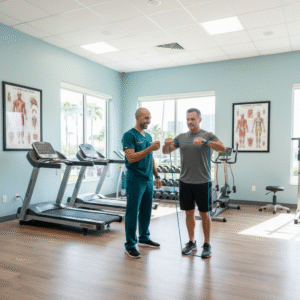Introduction
Many people ask themselves, “Is going to a physical therapist worth it?”, especially when dealing with pain, injury recovery, or post-surgery rehabilitation. While some try to “wait it out” or rely solely on rest, the truth is that physical therapy offers targeted treatment that can not only speed up recovery but also prevent future health problems.
Whether you’re an athlete, recovering from surgery, or simply dealing with everyday aches, a physical therapist (PT) can create a personalized plan to improve strength, mobility, and overall function.
What Does a Physical Therapist Do?
A physical therapist is a licensed healthcare professional trained to diagnose and treat movement-related issues. Their expertise covers:
- Pain relief techniques (manual therapy, massage, ultrasound therapy)
- Rehabilitation exercises for injuries and post-surgery recovery
- Mobility and flexibility training
- Strength and endurance improvement
- Education on posture, ergonomics, and injury prevention
Why People Seek Physical Therapy
1. Injury Recovery
From sprained ankles to torn ligaments, physical therapists create recovery programs that help restore strength and prevent re-injury.
2. Chronic Pain Management
Conditions like arthritis, lower back pain, and fibromyalgia can benefit from gentle strengthening, stretching, and mobility exercises.
3. Post-Surgical Rehabilitation
After surgeries like joint replacements, PT helps you regain full use of the affected area faster and with better long-term outcomes.
4. Sports Performance
Athletes use physical therapy not only to recover but also to optimize performance through specialized training plans.
Key Benefits of Going to a Physical Therapist
1. Speeds Up Recovery
Research shows that guided rehabilitation programs help patients heal faster than those who rely solely on rest.
2. Reduces Pain Without Medication
Physical therapy uses natural methods like manual manipulation, targeted exercises, and mobility work to reduce pain, often avoiding the need for long-term pain medication.
3. Prevents Future Injuries
By identifying movement weaknesses or imbalances, a PT can design a plan that minimizes your risk of future injury.
4. Improves Mobility & Flexibility
Whether you’re struggling to bend, walk, or stretch without discomfort, physical therapy can help restore movement and joint range.
5. Saves Money in the Long Run
While there’s an upfront cost, PT can reduce the risk of expensive surgeries, medications, or recurring injuries.
Is It Worth the Cost?
The cost of physical therapy varies depending on your location, insurance coverage, and the length of treatment. On average, sessions range from $50 to $150, but consider this:
- Avoiding surgery can save thousands of dollars.
- Preventing chronic pain can reduce ongoing medical expenses.
- Improving physical function can increase productivity at work and in daily life.
When you compare these savings to the cost of therapy, the value becomes clear.
Signs You Should See a Physical Therapist
You might benefit from PT if you:
- Have persistent pain lasting more than a week
- Recently had surgery or a sports injury
- Struggle with mobility, balance, or posture
- Experience stiffness after waking up or sitting for long periods
- Want to improve athletic performance safely
What to Expect During a Physical Therapy Session
A typical PT session includes:
- Evaluation & Assessment – Understanding your medical history, pain points, and movement patterns
- Treatment Plan – Custom exercises and therapy techniques designed for your specific needs
- Hands-On Therapy – Stretching, soft tissue massage, joint mobilization
- Home Exercise Program – Guidance on exercises you can do between sessions to speed recovery
Tips for Maximizing Your Physical Therapy Results
- Be Consistent – Skipping sessions slows progress
- Follow Home Exercises – They’re designed to reinforce clinic work
- Communicate – Tell your therapist about pain or discomfort immediately
- Set Realistic Goals – Recovery takes time, but steady progress is key
Conclusion
So, is going to a physical therapist worth it? Absolutely. From injury recovery to chronic pain relief and performance enhancement, physical therapy is an investment in your health that can save you time, money, and discomfort in the long run.
If you want to move better, feel stronger, and prevent future injuries, consider booking a consultation with a licensed PT. Contact us today!








